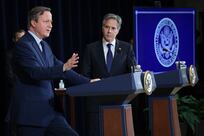In 1949, two British researchers, Richard Doll and Bradford Hill, found that of 649 lung cancer patients in London hospitals, 647 were smokers. Their work was arguably the most important moment in the earliest days of a public health campaign that has been going on since: reducing smoking. It has not been an easy one. While convincing the medical community of the dangers was first priority, doing something about it was more complex. It required engaging with and, at points, confronting some of the biggest conglomerates as well as the deeper social acceptance of a habit that had been practised so widely for so long.
Early strategies were very similar to today's. In 1962, smoking rates fell for the first time in a decade. Doctors' recommendations included heavy taxes, along with age and advertising restrictions.
In the Middle East, implementing such policies is imperative. The latest data from the World Tobacco Atlas shows that since 2009, the number of smokers increased in a 10-year period in four of the region's nations. This is worrying. The Middle East is already heavily burdened by heart disease and strokes – smoking is a major risk factor in both. Lebanon, whose healthcare system is at breaking point, has the highest number of smokers of any Middle Eastern country.
There were some positive stories from the region. In the UAE, the tobacco trade fell from Dh410 million in 2017 to Dh62.4m in 2019. This is widely credited to the UAE imposing in 2017 a 100 per cent excise tax on cigarettes. It vindicates advocates of economic strategies to tackle smoking. They include the WHO, who in its Framework Convention on Tobacco Control recommends that at least three-quarters of the price of popular tobacco brands be taxes.
This approach is also working in Saudi Arabia where a 2017 policy mandates that 68 per cent of the price of 20-cigarette pack be taxes. Further ones on imported tobacco have seen an almost 30 per cent decline in foreign cigarettes coming into the country. Overall, 37 per cent fewer people were smoking in 2022 compared to 2014.
In a sign of how complex the public health problem remains, there are still grounds for concern, even in countries where trends otherwise seem positive. Globally, in almost half of the 135 surveyed countries, smoking in people between 13 and 15 had increased, a sign that, alongside taxation, consumer awareness from a young age of the dangers is key.
Ongoing progress is not guaranteed, and new unknowns are emerging. The National spoke to Dr Davinder Pal Singh, a cardiologist at NMC Royal Hospital in Dubai, who drew particular attention to the issue of vaping, which he said had "increased rapidly in the past few years". A false sense of security might be driving the trend, even though the devices still contain tobacco. Dr Singh was clear: "It’s going to affect the heart ... It contains nicotine in some form. People should definitely avoid vaping. It’s the same as cigarettes.”
The picture from the latest tranche of data is mixed, then. While there is more evidence that regulation and legislation work, there is clearly not enough across the board, particularly when it comes to researching dangers of newer forms of tobacco consumption. For the Middle East, countries that are getting complacent should learn from the many neighbours taking effective steps with clear results. The dangers of smoking are obvious, but there are proven strategies to dealing with them. Ignoring them would be a betrayal of populations whose health is already too often precarious.












